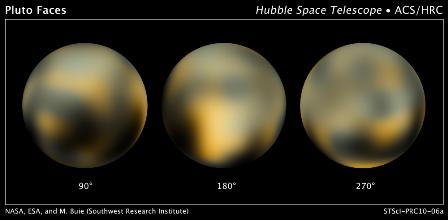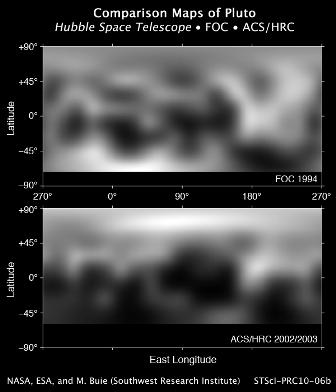Astronomy news
Remarkable changes on Pluto
witnessed by Hubble
15 March 2010
The dark, icy, dwarf planet Pluto is undergoing seasonal changes due to
its highly elliptical orbit. NASA has released some dramatic pictures
taken with the Hubble Space Telescope that clearly show differences over
a two year period.
Considering that Pluto takes 248 years to
orbit the Sun, astronomers were not expecting to find such obvious
alterations to the surface structure over so short a period. It would be
equivalent to the whole appearance of the Earth's surface changing in
only 72 hours.
Pluto has become significantly redder, while its
illuminated northern hemisphere is getting brighter. These changes are
most likely consequences of surface ice melting on the sunlit pole and
then refreezing on the other pole, as the dwarf planet heads into the
next phase of its 248-year-long seasonal cycle. Analysis shows the
dramatic change in color took place from 2000 to 2002.

The Hubble pictures confirm Pluto is a dynamic world that
undergoes dramatic atmospheric changes and is not simply a ball of ice
and rock. These dynamic seasonal changes are as much propelled by the
planet's 248-year elliptical orbit as by its axial tilt. Pluto is unlike
Earth, where the planet's tilt alone drives seasons. Pluto's seasons are
asymmetric because of its elliptical orbit. Spring transitions to polar
summer quickly in the northern hemisphere, because Pluto is moving
faster along its orbit when it is closer to the Sun.

Ground-based
observations, taken in 1988 and 2002 show the mass of the atmosphere
doubled during that time. This may be because of warming and melting
nitrogen ice. The new Hubble images are giving astronomers essential
clues about the seasons on Pluto and the fate of its atmosphere.
When the Hubble pictures taken in 1994 are compared to those of 2002 and
2003, astronomers see evidence that the northern polar region has gotten
brighter, while the southern hemisphere darkened. These changes hint at
very complex processes affecting the visible surface.
The images
will help planetary astronomers interpret more than three decades of
Pluto observations from other telescopes.
"The Hubble
observations are the key to tying together these other diverse
constraints on Pluto and showing how it all makes sense by providing a
context based on weather and seasonal changes, which opens other new
lines of investigation," says principal investigator Marc Buie of the
Southwest Research Institute in Boulder, Colorado.
These Hubble
images, taken by the Advanced Camera for Surveys, will remain the
sharpest view of Pluto until NASA's New Horizons probe is within six
months of its flyby during 2015. The Hubble images are invaluable for
picking the planet's most interesting hemisphere for imaging by the New
Horizons probe.
New Horizons will pass by Pluto so quickly that
only one hemisphere will be photographed in detail. Particularly
noticeable in the Hubble images is a bright spot that has been
independently noted to be unusually rich in carbon monoxide frost. It is
a prime target for New Horizons. "Everybody is puzzled by this feature,"
Buie said. New Horizons will get an excellent look at the boundary
between this bright feature and a nearby region covered in pitch-black
surface material.
"The Hubble images also will help New Horizons
scientists better calculate the exposure time for each Pluto snapshot
which is important for taking the most detailed pictures possible," Buie
said. With no chance for re-exposures, accurate models for the surface
of Pluto are essential for properly exposed images.
The Hubble
images surface variations a few hundred miles across that are too coarse
for understanding surface geology. But in terms of surface color andd
brightness, Hubble reveals a complex-looking world with white,
dark-orange, and charcoal-black terrain. The overall color is believed
to be a result of ultraviolet radiation from the distant Sun breaking up
methane present on Pluto's surface, leaving behind a dark and
red-carbon-rich residue.
The Hubble images are a few pixels wide.
Through a technique called dithering, multiple, slightly offset pictures
are combined through computer-image processing to synthesize a
higher-resolution view than can be seen in a single exposure.
"This has taken four years and 20 computers operating continuously and
simultaneously to accomplish," Buie said. Buie developed the special
algorithms to sharpen the Hubble data. He plans to use Hubble's new Wide
Field Camera 3 to make additional observations prior to the arrival of
New Horizons.
To top |